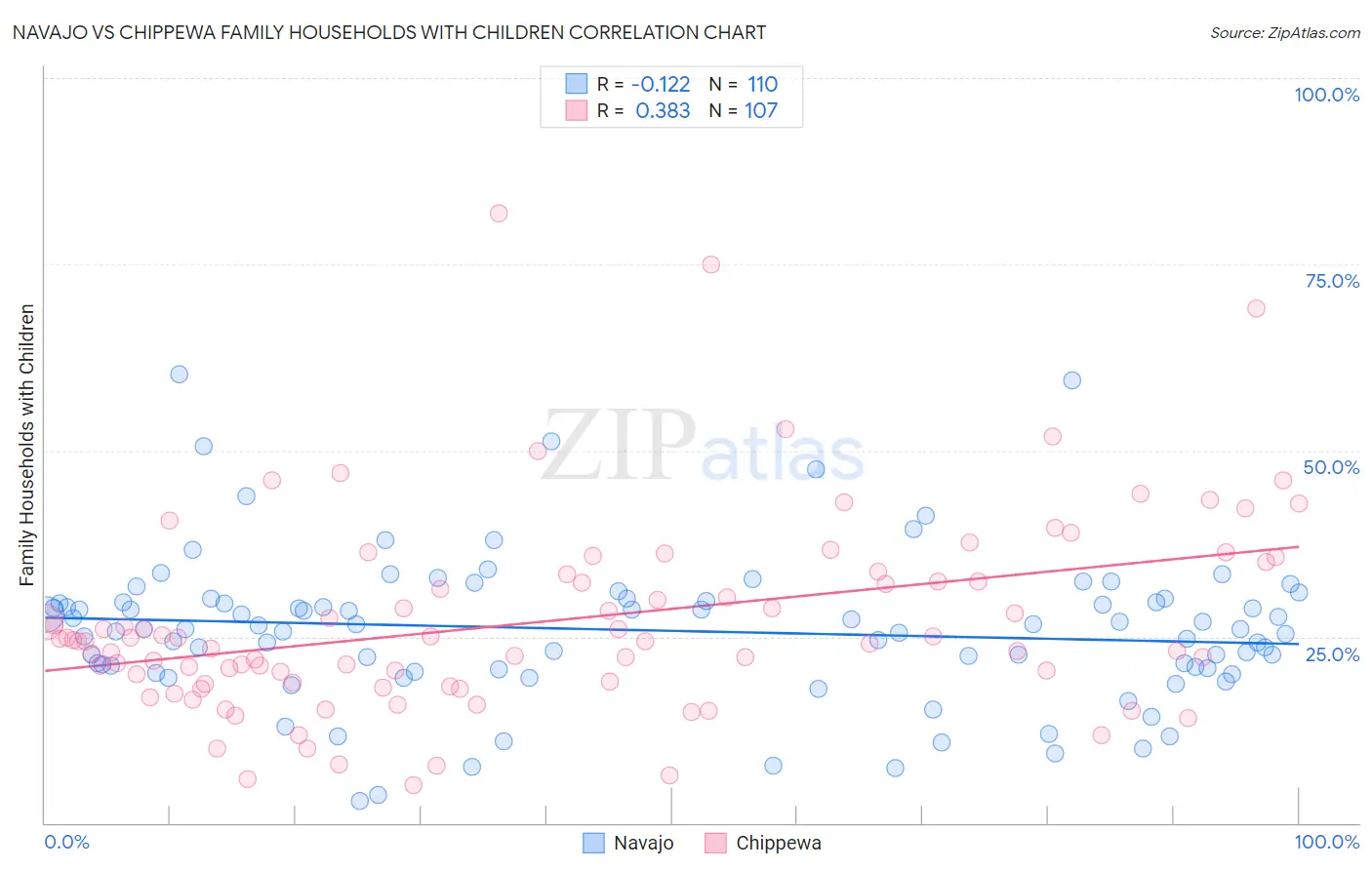Navajo vs Chippewa Family Households with Children
COMPARE
Navajo
Chippewa
Family Households with Children
Family Households with Children Comparison
Navajo
Chippewa
26.9%
FAMILY HOUSEHOLDS WITH CHILDREN
3.2/ 100
METRIC RATING
241st/ 347
METRIC RANK
26.7%
FAMILY HOUSEHOLDS WITH CHILDREN
0.9/ 100
METRIC RATING
265th/ 347
METRIC RANK
Navajo vs Chippewa Family Households with Children Correlation Chart
The statistical analysis conducted on geographies consisting of 224,710,255 people shows a poor negative correlation between the proportion of Navajo and percentage of family households with children in the United States with a correlation coefficient (R) of -0.122 and weighted average of 26.9%. Similarly, the statistical analysis conducted on geographies consisting of 214,955,892 people shows a mild positive correlation between the proportion of Chippewa and percentage of family households with children in the United States with a correlation coefficient (R) of 0.383 and weighted average of 26.7%, a difference of 0.73%.

Family Households with Children Correlation Summary
| Measurement | Navajo | Chippewa |
| Minimum | 2.9% | 5.1% |
| Maximum | 60.3% | 81.8% |
| Range | 57.4% | 76.8% |
| Mean | 25.9% | 27.1% |
| Median | 26.0% | 24.4% |
| Interquartile 25% (IQ1) | 20.8% | 18.9% |
| Interquartile 75% (IQ3) | 29.8% | 33.3% |
| Interquartile Range (IQR) | 8.9% | 14.5% |
| Standard Deviation (Sample) | 10.0% | 13.3% |
| Standard Deviation (Population) | 9.9% | 13.2% |
Similar Demographics by Family Households with Children
Demographics Similar to Navajo by Family Households with Children
In terms of family households with children, the demographic groups most similar to Navajo are Immigrants from England (26.9%, a difference of 0.0%), Immigrants from Bulgaria (26.9%, a difference of 0.010%), Immigrants from Southern Europe (26.9%, a difference of 0.020%), Moroccan (26.9%, a difference of 0.030%), and Immigrants from Netherlands (26.9%, a difference of 0.040%).
| Demographics | Rating | Rank | Family Households with Children |
| Immigrants | Germany | 4.4 /100 | #234 | Tragic 27.0% |
| Immigrants | Morocco | 4.2 /100 | #235 | Tragic 27.0% |
| Cape Verdeans | 3.6 /100 | #236 | Tragic 26.9% |
| Immigrants | Netherlands | 3.5 /100 | #237 | Tragic 26.9% |
| Moroccans | 3.4 /100 | #238 | Tragic 26.9% |
| Immigrants | Southern Europe | 3.4 /100 | #239 | Tragic 26.9% |
| Immigrants | Bulgaria | 3.3 /100 | #240 | Tragic 26.9% |
| Navajo | 3.2 /100 | #241 | Tragic 26.9% |
| Immigrants | England | 3.2 /100 | #242 | Tragic 26.9% |
| Immigrants | Saudi Arabia | 2.9 /100 | #243 | Tragic 26.9% |
| Ukrainians | 2.9 /100 | #244 | Tragic 26.9% |
| Australians | 2.8 /100 | #245 | Tragic 26.9% |
| Jamaicans | 2.5 /100 | #246 | Tragic 26.9% |
| Potawatomi | 2.2 /100 | #247 | Tragic 26.9% |
| Immigrants | Kazakhstan | 2.2 /100 | #248 | Tragic 26.9% |
Demographics Similar to Chippewa by Family Households with Children
In terms of family households with children, the demographic groups most similar to Chippewa are Taiwanese (26.7%, a difference of 0.010%), Maltese (26.7%, a difference of 0.010%), Immigrants from Uzbekistan (26.7%, a difference of 0.010%), Immigrants from Belgium (26.7%, a difference of 0.020%), and Immigrants from Russia (26.8%, a difference of 0.040%).
| Demographics | Rating | Rank | Family Households with Children |
| Immigrants | Cuba | 1.3 /100 | #258 | Tragic 26.8% |
| Immigrants | Lithuania | 1.2 /100 | #259 | Tragic 26.8% |
| Immigrants | Jamaica | 1.2 /100 | #260 | Tragic 26.8% |
| Immigrants | Belarus | 1.1 /100 | #261 | Tragic 26.8% |
| Immigrants | Russia | 1.0 /100 | #262 | Tragic 26.8% |
| Immigrants | North Macedonia | 1.0 /100 | #263 | Tragic 26.7% |
| Taiwanese | 0.9 /100 | #264 | Tragic 26.7% |
| Chippewa | 0.9 /100 | #265 | Tragic 26.7% |
| Maltese | 0.9 /100 | #266 | Tragic 26.7% |
| Immigrants | Uzbekistan | 0.9 /100 | #267 | Tragic 26.7% |
| Immigrants | Belgium | 0.9 /100 | #268 | Tragic 26.7% |
| Immigrants | Denmark | 0.8 /100 | #269 | Tragic 26.7% |
| Immigrants | Zaire | 0.7 /100 | #270 | Tragic 26.7% |
| French | 0.7 /100 | #271 | Tragic 26.7% |
| Somalis | 0.7 /100 | #272 | Tragic 26.7% |